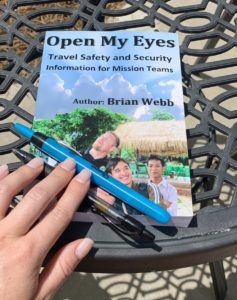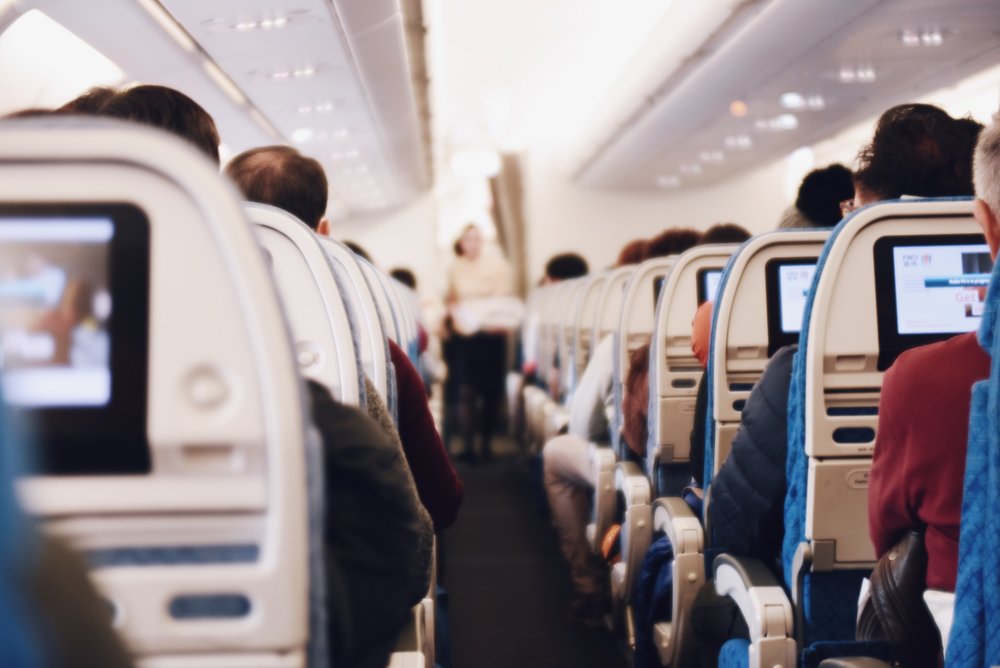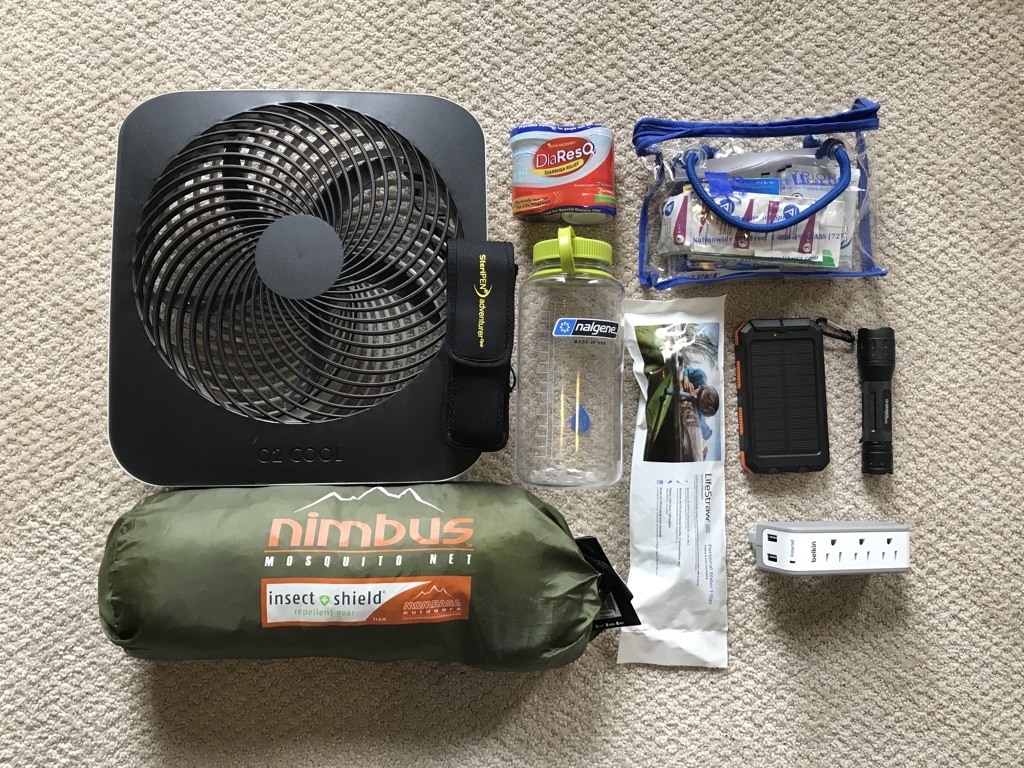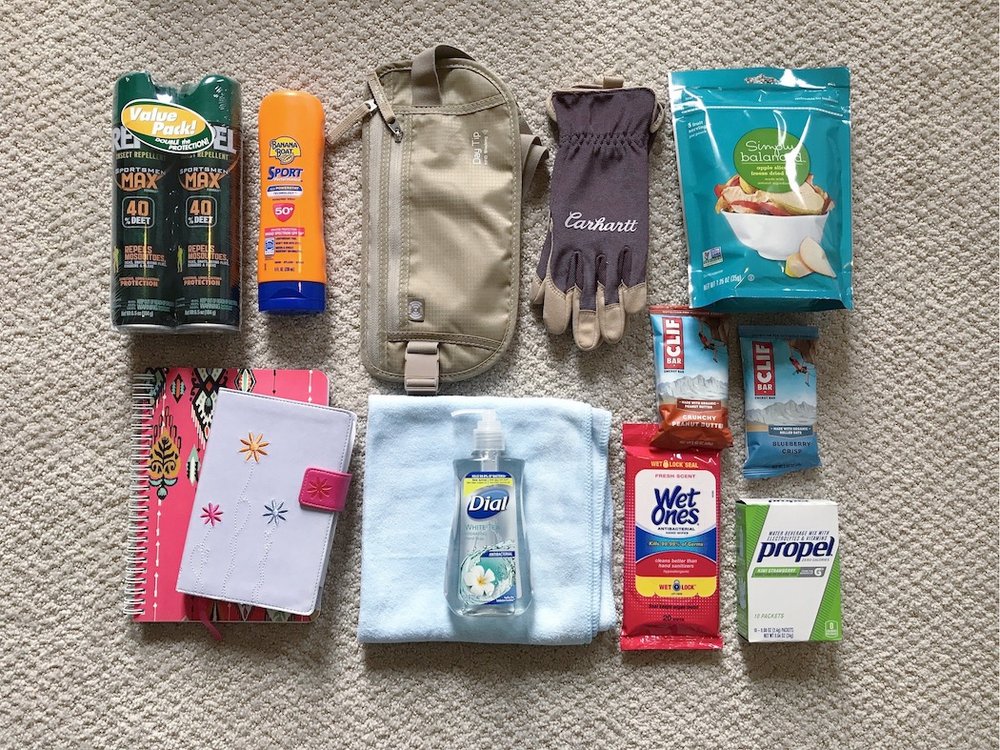 In less than 2 weeks, our team will be leaving for Haiti! A while back, each of us attended a security training at NorthPoint Church, presented by Brian Webb. I also just finished his book, ”Open My Eyes”, which elaborates on the information he shared at the training through the lens of mission travel. As I’ve been reflecting upon the material, I couldn’t help but share it with you. It’s simply too important not to pass along, and easy to share, with the possible reward of a life saved. Therefore, this month’s story is a little different from those past. It’s a bit serious and maybe even a bit frightening to learn about the realities of security around the world, but as Brian mentions often throughout his book, “With proper training and awareness of the dangers you will not only be safer but it will be possible to live life nearly free of fear!”
In less than 2 weeks, our team will be leaving for Haiti! A while back, each of us attended a security training at NorthPoint Church, presented by Brian Webb. I also just finished his book, ”Open My Eyes”, which elaborates on the information he shared at the training through the lens of mission travel. As I’ve been reflecting upon the material, I couldn’t help but share it with you. It’s simply too important not to pass along, and easy to share, with the possible reward of a life saved. Therefore, this month’s story is a little different from those past. It’s a bit serious and maybe even a bit frightening to learn about the realities of security around the world, but as Brian mentions often throughout his book, “With proper training and awareness of the dangers you will not only be safer but it will be possible to live life nearly free of fear!”
Brian’s bio is extensive, (and can be seen at the end of the story), but here are a few highlights: He served for nearly a decade as the National Program Manager for a government special operations program, he’s managed covert operations throughout the US and numerous foreign countries for 20+ years, he was certified as a Federal Law Enforcement Training Center (FLETC) Instructor, being the primary instructor for government law enforcement special operations since the mid 90’s, and is considered one of the world's leading experts in international narcotics smuggling and airborne counter terrorism operations. In short, he’s the guy I want to learn from when it comes to travel safety and security! Likewise, I’m so thankful he’s found a way to share his experience in training others how to prepare and equip themselves for dangerous situations.
First things first
The information I’m sharing here is taken from Brian’s safety and security seminar, as well as his book, “Open My Eyes”, which was developed specifically for issues encountered during mission trips to metro cities and remote areas of the world. (I had a chance to meet him at the training and he gladly allowed me to share this with you!) The bulleted tips are either taken directly from his book or paraphrased by me, with added commentary from me throughout. While some may think it’s a bit over the top to consider these extreme scenarios, the reality is, these things do happen. From his extensive experience traveling to different countries for specialized missions, Brian has analyzed the issues that repeatedly get people into trouble and then developed specific training on how to identify potential risks and avoid them. There’s so much great information that not all of it can be included here, but I’m including bulleted highlights I think could be either lesser known information or most helpful to you. I hope you’ll read all the way through - we’ll start with easier topics and end with the rather uncomfortable and critical ones, like hostage survival. So here we go, let’s jump in!
Pre-travel Prep & Packing
-
Review your medical and life insurance policies to see if they provide coverage in the country you’ll be visiting, and ensure they have these two functions: Medical and Political Evacuations. Interesting note: Life insurance policies won’t pay anything if you are killed while traveling in a country with an active State Department Travel Warning!
-
Place two I.D. tags on your bag. One on the outside, and one on the inside. That way, if the outside tag rips off, airport personnel can identify who the bag belongs to before it goes to the action house for lost/unclaimed luggage.
-
For specific packing tips, take a read over a story I wrote last year before our trip to Haiti, Mission Trip Packing List. Multiple tips came from Brian’s training!
-
Regardless of what you pack in your checked luggage, it’s a good idea to pack essentials in your carry-on in case your luggage gets lost: a change of clothes, toiletries, medications, and travel documents.
Travel Safety
Flights
-
First, consider what you’re wearing on an airplane to be important. To my surprise, I learned that wearing nylon/spandex leggings and flip flops are the WORST items you can wear on a plane. Um…that’s literally what I used to wear almost every time I’d fly, especially if I was going to the beach! There are two reasons for this:
-
Many people who were wearing nylon/spandex clothing during a plane crash have died or have suffered horrible burns, because the material melted into their skin within seconds of touching fire. In fact, you don’t even have to touch the fire. Just running past the flames can cause the material to melt into your skin.
-
Flip flops will be the first to fall off in an impact crash. Without shoes on your feet, you’re unable to protect them from burning objects or broken glass when trying to get out of the plane. It makes it much harder to run away from the crash too!
-
-
The number one cause of deaths and major injuries during airline accidents with people who survive the impact, but die before getting out of the plane, is smoke inhalation. Yet again, I was very surprised to learn this! Smoke rises in an airplane cabin, and in a panic, most people race to the center aisle and try to get out the front of the plane where they came in. This causes the aisle to become crowded with people, and unable to move, they’re forced to inhale the toxic fumes. How to prevent this?
-
Stay below the smoke.
-
Grab a piece of cloth (towel, shirt, etc.) from your bag and get it wet, if possible. Then place it over your mouth and nose to help filter the fumes while you breathe.
-
Choose a seat near an emergency exit. In an emergency, while most people are running to the front of the plane, you’ll be able to exit on the side of the plan through the emergency exit. If a seat by an exit isn’t available, count the number of seats to the exit when you sit down, so that if an emergency arises, you can climb over the top of the seats. Even if you can’t see because of smoke, you’ll be able to count the number of seats as you go. Plus, since many people will be in the aisle, the seats should be rather clear!
-
-
People’s reactions to emergencies generally fall into these categories:
-
10-15% react appropriately
-
75% have to be told what to do
-
10-15% react inappropriately
This means a certain percentage of people will be “frozen in fear”. If you find one of these people as you’re climbing over seats, shake them out of their shock and tell them to follow you. You could just save their life!
-
-
The number two cause of deaths during airline accidents from people who survive the impact but die before getting out of the plane is from flail or impact (from flying debris) injuries. Further, many people die from smoke inhalation, because they first endured an impact injury and couldn’t unlatch their seatbelt to get out of the seat! How to prevent flail injuries?
-
Adjust the way you sit during takeoff and landing! Sit up straight, sit as far back in your seat as possible, tighten your seatbelt, put your feet flat on the floor under you (not under the seat in front of you), and either cross your arms in front of you or sit on your hands. Sitting this way will prevent your legs from getting smashed from the seat in front of you if it collapses, and prevents your arms or body from flailing about the cabin.
-
Stay seated until the airplane comes to a stop. Often times, in an impact, a plane will hit the ground and then bounce back into the air for a period of calmness, before hitting again. If you unbuckle your seatbelt during that period of calmness, you’ll go flying when the plane hits the ground a second time.
-

Hotels
-
When checking into a hotel, ask if they have any rooms available between the 2nd and 6th floors. The first floor is not preferred from a security standpoint, as a criminal would rather commit their crime and run, rather than having to go down several flights of stairs. Secondly, the ladder of a fire truck can’t reach past the 6th floor, so you’re forced to walk down the stairs through potential smoke and flames in the instance of a fire.
-
Many robberies and sexual assaults that have taken place in hotels, have occurred in elevators. Statistically, the culprits are males between the ages of 18-35. If the elevator door opens and you see a single male/group of males and you feel uncomfortable, act like you forgot something and walk back to your room until the elevator door shuts.
-
Never open the door when someone knocks claiming to be the hotel manager or security! Instead, call the front desk to ask why there is someone at your door. If it’s not the manager or security, report it immediately.
-
If an emergency arises while you’re in a crowded building, most people will flock to the main door where they arrived. Statistics show that just about as many people die trying to get out of the building (from getting trampled) than they do from the actual cause of the emergency. How to avoid this moving sea of people?
-
If you can’t be one of the first people out the door, find an alternate exit through either a highlighted emergency exit or a back kitchen door.
-
If you happen to get caught in a moving crowd, first realize you’re in a dangerous situation and find a way out of the crowd. Handle the situation very much like a rip tide at the beach. As you move forward, try to work your way to the outside edge of the crowd until you hit the wall of the building and can move along the wall to an alternate exit.
-
Situational Awareness
-
When people get outside their comfort zone, their natural tendency is to get tunnel vision. This is the brain’s way of defense and a subconscious way of coping with uncomfortable surroundings. If you ever find yourself in a situation where you notice you’re experiencing this, stop to look around and observe what is happening around you. Your brain may have received some sort of intuitive alert of danger that you should be paying attention to! I took a self-defense class in college and this was one of the things they mentioned too - if you feel uneasy, in most instances there is a reason for it, even if we don’t consciously know why.
-
If you notice someone watching you, look directly back at them. Visually scan them from head to toe, making note of what they look like and letting them know you won’t be an easy target.
-
If you think you are being followed, make 3 consecutive turns in the same direction. After three turns, you’ll be headed back towards the same street you started on. If they’re still on your tail, they’re following you! Drive to the nearest police station or heavily populated area.
-
Pay attention to the security practices around you when in another country. Is there wire or a wall along the perimeters of properties, or windows with bars? This doesn’t necessarily mean you’re in danger, but may be a sign you’re in an area where taking extra precautions are a good idea.
Active Shooter
-
Historically, the general procedure for handling an active shooter situation has been to lock down the building with everyone inside. However, this only works if the shooter is OUTSIDE the building. The average time for the police to respond and enter a building is 5-10 minutes and almost all active shooter situations are over in 3-5 minutes, which means the damage usually takes place before the police arrive. So, if the shooter is inside the building, what is the correct response?
-
Run- Get out of the building as fast as you can. Most shooters walk into the front of the building. Run away from the sound of gunfire - away from the building and far enough from the range of fire.
-
Hide - If you can’t get out of the building without encountering the shooter, get out of site and hide. Do not huddle in a group. Hide away from each other and silence your phone. Also, if there is a door, lock and block it.
-
Fight - If your only option is to fight, go down fighting with the chance of survival. Look around and see what you have near that could be used as a weapon. This is not to discount the fact that it’s extremely difficult for an unarmed person to fight someone with a gun, but it may be your only choice.
-
-
When the police arrive, stay hidden where you are if possible. Their first priority will be capturing the shooter, before they can rescue you.
Foreign Travel
-
Create an emergency action plan and research the country you’ll be traveling to. What are their customs and norms? What parts of the country/city are safe/not safe? If an emergency were to take place, where is the nearest U.S. embassy? What neighboring countries are safe and welcome Americans, and which ones do not?
-
Check for Department of State travel advisories and register your travels with the Smart Traveler Enrollment Program (STEP) program.
-
For reports on security related issues you can also visit the Overseas Advisory Council website.
-
Buy a Kwikpoint International Travel Translator. It’s a fold-out card that includes multiple categories of pictures to aid communication in countries in which you can’t speak the language. I think this is so handy and I purchased one myself!

Hijackings, Terrorism, & Kidnappings
I have to preface these sections by saying they’re a bit uncomfortable (at least for me). I also know there’s a lot of information here, yet at the same time these sections were some of the most eye opening for me. Learning this, helped me feel more secure by knowing, at least, what to expect in such horrible situations. I hope it does the same for you!
-
First, hijackings - there are two types: criminal (have a demand) or Terrorist (want control of the plane). In a criminal situation, it’s best to stay in your seat and not make yourself known. If it’s a terrorist hijacking, wait 20-30 seconds to see if an air marshall is on board. If yes, stay low and out of the line of fire. If no, do absolutely whatever it takes to stop their attempts to take a control of the aircraft, even if it means you or others die in the process. The reality here is that everyone on the plane will die if the terrorists succeeds.
-
Every country in the world has active terrorist organizations operating inside their borders, including right here at home. America has as many, if not more terrorist organizations than anyone in the world.
-
Every major terrorist organization in the world is primarily funded by the drug trade.
-
Only 10% of all kidnapping cases are ever reported to the authorities and most incidents are handled directly by the family, church, or a private hostage negotiation business instead of through law enforcement or the government. Therefore, multiplying the number of incidents we hear about by a factor of 9 or 10 would present a more accurate representation of incidents. This helps us understand a better picture of how often kidnappings happen.
-
Many of us are under the false belief that our government will come to our rescue if we are kidnapped in a foreign country, which just doesn’t happen (except in rare circumstances). The US policy states, “When Americans are abducted overseas the US government looks to the host government to exercise its responsibility under international law to protect all persons within its territory and bring about the safe release of the hostages.”
Criteria common to kidnapping:
-
-
Kidnappings take place at a chokepoint near the victim’s residence/hotel or where they work - simply because this is where the individual commonly ends up during a usual day.
-
The victim’s pattern is predictable, showing up at chokepoints at a similar time each day.
-
The attack site is often a place where the attacker is able to observe patterns and movements for weeks before the attack.
-
How to prevent a kidnapping:
-
-
Good tactics refer back to knowing your surroundings, and letting people know you’re aware they’re watching you. Also, stay in groups!
-
If you’ve noticed you’re being followed, you could: notify the police, change hotels, or change your daily patterns.
-

Basics of Hostage Survival
-
Kidnappers usually fall into these categories: political extremists, criminals, religious fanatics, and those mentally disturbed.
-
Everyone who becomes a hostage victim goes through four psychological stages during captivity (I compare these in some way, to the stages of grief):
-
Shock & Disbelief - People often experience thoughts of, “This isn’t really happening” or “Although this looks bad, everything is going to be okay”.
-
Reality - Once they realize the situation is real, they are suddenly overcome with a feeling of total despair. Many describe the feeling of a physical weight being placed on their shoulders. Brian himself, has been taken and held hostage while undercover in another country, and he described the feeling in exactly this way.
-
Adaptation - A person wants to get to this phase as soon as possible, because it’s the phase in which your brain starts to think logically to concentrate on survival. You also want to stay in this phase without dipping into the next stage if at all possible! You are most likely to escape within the first 15-45 minutes of being captured - the culprits are likely relocating you to a place where they’ll have more control and until then, nothing is fully in their control. At the same time, because they don’t have full control, they’ll be insecure and could react in extreme ways to any attempts you make to break free. This is why it’s so important to move to the adaptation phase as quickly as possible - so you can start to analyze the situation, and if you decide to attempt to break free, it can be done within the first few minutes. Before making a decision, it’s important to consider, “Why have I been taken hostage?” If it’s for ransom, you’ll likely be released at some point and you may not want to risk getting killed while trying to get away. If it’s for political or religious reasons, it’s unlikely you’ll make it home, so you don’t have much to lose in attempting to escape. If you decide to escape, it needs to be an all-out effort. If it’s not successful you probably won’t survive the day.
-
Traumatic Depression - This is the point at which a hostage would rather die than be kept captive and it’s a very dangerous place to be mentally. Many have died out of simply giving up in these situations. On the contrary, 80% of people held for ransom are released at some point - which is why it’s so important to keep a positive mind and work to stay alive. In order to handle this stage, it’s important to realize you’ll probably reach this stage at some point and then recognize when you do, finding things to keep your mind and body busy.
-
-
If it happens that a rescue comes your way, do not grab a weapon to help. Instead, find a safe place out of fire and stay hidden until they’ve made the area safe. Then, listen to and follow orders carefully.
See, I told you it was going to end a little heavy! I know it’s uncomfortable to think about ever having to be in that situation. For me, it would probably be my worst nightmare, but I do believe I’d be so thankful I took the time to at least know what to expect, so I could recognize some of the stages and know what to look for.
“Many people think that if you hear about all the dangers in the world that you’ll walk around scared the rest of your life, but just the opposite is true. With proper training and awareness of the dangers you will not only be safer but it will be possible to live life nearly free of fear!” - Brian Webb
There are so many more great tips packed into Brian’s workshops and books, but these are just a few I thought could be surprising, interesting, and the most critical to know in a difficult situation. And remember, knowing these things doesn’t make traveling more freaky, it simply makes us safer!
How can I learn more?
-
Check out Brian’s website and seminars offered: Safety and Security Training for corporate, business, and mission travel, Crisis Management and Disaster Planning, Survival Training, Active Shooter, and Airline Crew Member Security Training. You can also purchase his books, “Open My Eyes” for mission travel, or “Business travel Safety” for those traveling for business.
-
Summer is the time of year many go on mission trips. Share these tips with your friends who are giving of their time and hearts to others around the world. Help them become aware of this important safety information. It may just save their life!
-
Pass this information along to someone you know, even if they aren’t traveling on a mission trip. Regardless if they’re going on a mission trip, vacationing for leisure, or simply out-and-about near home, this information is applicable everywhere. It’s good, important stuff to keep in our back pocket, ready to pull out when a sticky situation catches us by surprise.
Did you find this information helpful? Let me know in the comments below! Want to connect with Brian about a seminar or book? Contact him directly via his website, and he’ll be happy to discuss with you!
*Disclaimer: This information will not expressly keep you safe on its own and is not intended to be a comprehensive training for human safety and security. These are simply tips/tricks shared for the greater good of society. Each person who employs these tactics are voluntarily doing so at their own risk.
Brian Webb, CEO/Instructor
Brian Webb is the Owner and primary instructor for IHS Training LLC. Brian is a renowned expert in International Travel Safety and Security, and Crisis Management & Disaster Planning. He has lived and worked in some of the most remote and dangerous parts of the world. During his career in Federal Law Enforcement, he served for nearly a decade as the national program manager for a government special operations program. Brian has managed covert operations throughout the US and numerous foreign countries for 20+ years.
Brian was a professional pilot by trade and a former airline pilot who made his way into law enforcement. In 2013 he retired as a pilot and Federal Agent for the Department of Homeland Security. He is considered one of the world's leading experts in international narcotics smuggling and airborne counter terrorism operations.
In addition to managing a covert operations program, Brian also served as the national program manager of the agency's Primary Aviation Survival School as well as Chief of the Standardization Training Branch and he continues to work as a survival instructor.
Brian has been teaching government employees, corporate executives and business travelers, missionary organizations, church mission teams and airline crew members how to travel into and out of foreign countries for over two decades. He was certified as a Federal Law Enforcement Training Center (FLETC) Instructor and has been the primary instructor for government law enforcement special operations since the mid 90's. His students include Homeland Security, DEA, several of the US Intelligence Agencies, the Royal Canadian Mounted Police and a number of other foreign governments.
In 2011 Brian was the sole recipient of the National Training Award and received the national award for Outstanding Achievement in Training from the Department of Homeland Security's Office of Air Operations, and in 2015 he received the top award for Organized Crime Investigations (OCEDTF).
Brian specializes in teaching International Travel Safety and Security, Crisis Management and Survival Training. He teaches in corporate settings for business travel, and also teaches church mission teams how to travel safely around the world with a biblical perspective on safety and security.



Be the first to comment